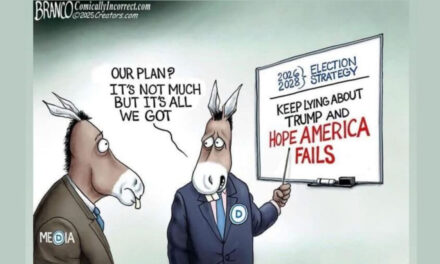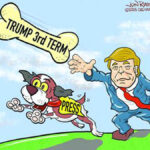
Recession Coming? Perhaps or Perhaps Not, But Here’s What to Look For

Economic downturns don’t happen overnight. They build slowly, with warning signs appearing in different sectors before a full-blown recession takes hold. While job reports and stock market movements provide some clues, economists and analysts also look at less conventional indicators—like sales of mini liquor bottles and men’s underwear—to gauge consumer behavior and business confidence. Understanding these signals can help individuals and businesses prepare for economic turbulence before it fully materializes.
Additionally, government spending is a direct contributor to GDP, meaning that Musk inspired cuts in federal programs and employment can initially make the economy appear weaker. However, in the longer term, private industry is expected to generate more economic activity than the government reductions take away, leading to overall growth and stability.
So, are we on the brink of a recession? Some experts believe we are getting dangerously close, while others argue the economy remains resilient. Let’s explore the key indicators that might signal a downturn and where the experts stand on the issue.
Who Thinks We’re Close to a Recession?
Several economic analysts and financial institutions have raised concerns about an impending recession. Goldman Sachs recently increased its recession probability from 15% to 20%, citing policy changes as a key risk. J.P. Morgan is even more cautious, placing the chances at 40%, largely due to trade uncertainties and regulatory shifts.
Meanwhile, a forecast from the Federal Reserve Bank of Atlanta suggests that first-quarter GDP may decline by an annualized 2.4%, which would mark the first contraction since 2022. Investors are also feeling uneasy. “There are always multiple forces at work in the market, but right now, almost all of them are taking a back seat to tariffs,” said Chris Larkin, managing director at E-Trade from Morgan Stanley. Tariffs, along with government spending cuts and regulatory uncertainty, have made it harder for businesses to plan for the future.
Additionally, many business leaders have expressed growing concern. Corporate conference calls have shown a sharp drop in mentions of a “soft landing,” a term used to describe a slowdown that avoids recession. The phrase appeared in 61 U.S. company conference calls in the last quarter of 2024 but has dropped to just seven mentions so far in 2025. This suggests that business leaders are becoming less confident in the idea that the economy can slow without tipping into a recession.
Who Says We’re Not There Yet?
On the other side, the White House and some key economic analysts maintain that while growth may slow, a recession is not imminent. President Trump has downplayed recession fears, describing the current period as a “detox” phase in the transition to new economic policies. Treasury Secretary Scott Bessent echoed this sentiment, saying that the economy needs time to shift “away from public spending to private spending.”
The New York Federal Reserve remains optimistic, forecasting a 2.7% GDP growth for the first quarter of 2025. Furthermore, despite rising layoffs in certain industries, the broader labor market remains historically strong, with an unemployment rate of 4.1%. While consumer spending has shown some signs of strain, it has not collapsed, and the stock market, despite recent volatility, remains up over the past year.
Key Indicators of a Recession
Job Market Weakness
The job market is one of the earliest and most reliable indicators of economic trouble. While the U.S. has continued to add jobs, there are warning signs that a slowdown may be coming:
- Planned job cuts surged in February, reaching levels not seen since the pandemic. According to Challenger, Gray & Christmas, U.S. employers announced 172,017 planned job cuts in February, nearly triple the pace of 2024.
- Federal job losses are rising due to government cutbacks, particularly in agencies impacted by Trump administration policies. “With the impact of the Department of Government Efficiency (DOGE) actions, as well as canceled government contracts, job cuts soared in February,” said Andrew Challenger, senior vice president at the outplacement firm.
- Worker confidence has declined sharply, with fewer employees believing their company’s outlook is positive. Data from Glassdoor shows that the share of employees reporting a positive six-month outlook for their employers fell to 44.4% in February, the lowest level on record since 2016.
- Unemployment claims are ticking higher in certain regions, particularly in areas dependent on government funding. In Washington, D.C., Virginia, and Maryland, claims are up 49% year-over-year, reflecting the strain on businesses that depend on government spending.
Declining Consumer Spending
Consumer spending drives about two-thirds of the U.S. economy, making it a critical indicator of economic health. Recent trends show signs of consumer caution:
- Lower discretionary spending: Americans are cutting back on non-essential purchases. “It’s a consumer that is pinched,” said Lawson Whiting, CEO of Brown-Forman, the company behind Jack Daniel’s whiskey. Sales of smaller liquor bottles, or “nips,” have surged as consumers look for cheaper options.
- Retail shifts: Walmart reports that customers are buying smaller pack sizes at the end of the month, indicating that money is running out before payday.
- Luxury retail slowdown: High-end stores have seen fewer purchases as wealthier consumers also tighten their belts. American Eagle Outfitters CEO Jay Schottenstein noted that “fear of the unknown is weighing on customers.”
- D.C. spending slump: Unlike other regions, spending in Washington, D.C., continues to decline, likely tied to federal layoffs.
Stock Market Volatility
A declining stock market isn’t always a direct sign of a recession, but it can signal investor uncertainty. Over the past month:
- The S&P 500 has fallen more than 7%, erasing gains since Trump’s reelection.
- Tech stocks like Tesla (-36%) and Nvidia (-25%) have seen sharp declines, reflecting fears about tariffs and trade policy changes.
- Businesses are cautious about investing, with fewer hiring announcements and capital expenditures slowing.
Rising Credit Card Debt and Delinquencies
As inflation and interest rates strain household finances, more Americans are relying on credit. Warning signs include:
- Record-high credit card debt surpassing $1.21 trillion.
- Increase in late car payments, reaching the highest level since 2010.
- More hardship withdrawals from retirement accounts, as families struggle to cover emergency expenses.
Unconventional Economic Indicators
Economists also look at smaller, seemingly unrelated trends for signs of a downturn:
- Men’s underwear sales: Former Federal Reserve Chair Alan Greenspan once noted that declining men’s underwear sales could signal a downturn, as consumers put off buying basic items.
- Mini liquor bottles (“nips”) sales rise: A surge in purchases of smaller liquor bottles suggests cost-conscious consumers are looking for ways to stretch their budgets.
- Cigarette sales: More smokers are buying single packs instead of cartons, a common trend in recessions.
- Inverted yield curve: When long-term bond yields fall below short-term yields, it often signals investor fears of an economic downturn.
- Gold prices soaring: Investors flock to gold as a safe haven when they anticipate market instability. Gold recently hit a record $3,000 per ounce.
FAM Editor: Recessions have a large psychological component, if we are told to have certain expectations then that perceptions become reality. Trump has a great deal of control over that narrative. We believe that we will come close to the recession line but an actual recession will not occur.
























The technical definition of recession being two negative quarters of GDP means by the time you define it, you have been in it for two quarters, it may even be ending by the time you define it. Tis the nature of the metric that you know you are in it months before you define it. The last negative gdp quarter was q12022. This quarter will not be negative, but it will not be good either for Trump has screwed the pooch and the Biden economy, with it’s good numbers, is coming to an end. The technical decision is no longer believed to be the sole measure and financial houses, think tanks, and even the Biden administration has revamped the metrics so that no one understands them and everyone can debate them… I have one adage, more true today than every: “wherever you are in the economy, you have never been there before.” That does not mean you trash all the cute things Daniel has said; it just means you are at a new place in the economy so using them as the sole predictor would be rash. Think Pirates of the Caribbean, not rules, more like guidelines.
Also, my simplest definition of recession: too little money. As to inflation: too much money. And IMO, that’s the driver. After covid and all those stimuli: too much money. Post that under Biden: close to not enough money, but not quite yet. So we invented the term: soft recession. FYI: too little money means people stop buying, factories overproduce, people get fired, yada, yada. But how do you measure too little money. It can be an idea, a thought, a feeling, having nothing to do with actual green stuff. For example, after the stimuli, too much money but not really because people just banked it, did not spend it, no inflation —– at first. But when it came, it was a tsunami of too much money as we all together opened our wallets and splurged.
Here’s my point. On top of everything else, Trumusk is fucking with our economy in a dangerous and uncharted way. The Federal Government is 40% of our workforce and maybe 30% of our GDP. IF Trump lets go 10% of his workforce, then we have an additional 4% of unemployment. You do the math and you figure out how long it will take Trump to make all those factories and all those businesses to hire 4% of the workforce. And that’s just at a 10% reduction by Trumusk. It’s a pretty big hit and it will hit pretty big, fast.
Trump’s tariffs are a tax that we all pay. He then puts those taxes in the General Fund to cover whatever he needs to cover like all those new unemployment checks going out. But the consumer pays the tax the same way you all feel the pain of increased minimum wage affects your price. Depending on what he does, this is instant inflation of the shooting yourself in the foot kind.
Trump’s trade war cuts two ways, both imports and exports will be lower. That means less business in America.
Trump’s spending must be off the wall and it appears no one is counting. The cost of deportations. The unemployment costs of the firings. The court cases of the firings, deportations, and other actions. The troops we are paying for on the border. These are all mounting up and no one knows how we are paying for all this. But we will soon and it will not be good.
These are just two extreme actions that could easily push us towards recession. And the downstream effects of all the unemployed not spending creates trickle-down of a bad variety.
The other is chaos and uncertainty. Investors and consumers like stability before making dollar decisions. We save our cash when it looks like we might need it to cover chaos, or might hold back and wait during uncertainty. This can represent not enough cash as spending and investment dry up for no better reason than we are uncertain about the future.
Based on what Trump is doing, the range, the speed, of the firings, layoffs, paid-to-leave programs, I expect this downturn will not be covered by what he is doing, if anything, to create GDP growth. It’s not that what he is doing is wrong; but I am certain the he is doing it the wrong way without checks and measures, without a plan, and with so many moving parts that there will be much breakage. And breakage is added cost, every time.
Then again, nothing may happen and our economy may be like a pile of puppies. Remember, we have never been in this spot in the economy and we have never acted like this. And in that spirit, here’s my recession indicator:
Economist George Taylor proposed the “hemline index” in the 1920s, suggesting that skirt lengths rise during economic booms and fall during recessions.
Rationale: The theory posits that during prosperous times, women feel more confident and want to show off their legs and stockings, leading to shorter skirts. Conversely, during economic hardship, women might favor longer, more modest styles.
Examples:
Roaring Twenties: The economic boom of the 1920s saw the rise of flapper dresses with shorter hemlines.
Great Depression: The economic downturn of the 1930s brought longer skirts and more conservative styles.
Post-War Boom: The post-war economic boom of the 1960s saw the emergence of mini-skirts.
What’s in your wallet and how short is your skirt?
I think there is little doubt that we are in for some volatility in the near term. But I’m thinking and will give odds that most of the tariffs will disappear as Trump negotiates and gets what he really wants. Then as construction on data centers, reopening of mines, pipelines, and other activity start to pick up, the economy will pick up and will boom by the 18 month mark. In fact, this may be what is being aimed for to give Trump a favorable congress after the mid terms.
Good luck.
Data centers is a biden plan that Trump is continuing. Could help, but not many are needed to work there.
Mines reopening?
Pipelines?
Against the costs you are accruing, that’s pretty wishful thinking. From Trump 1’s term, much forecasted like rhis never happened. Coal did not come back. Biden drilled more oul. AI has already floundered although will be certainly a boost to gdp over time.
You are spending too much, making too little and if history is a precedent. getting ready for tge deficits once again. And then, the consumer will pull back and you will have recession, just like Trump 1’s recession.
Too much hacking and not enough revenues. We gotcall negative numbers and few positives so far.
Good to have a drwam though.
The fact is that inflation has cooled under Biden but is still too high under Trump and worse, it’s spotty things like eggs. Not good given we are about to be hit with the tariff tax, an inflation of our own making. Trump’s response to bird flu is reminiscent of his initial covid response telling us it will go away by itself. His trade war is that; there will be casualties. Jobs report was nice although lower than anticipated. Still down over 50% from December’s 300K and off by 50% for seasonal job additions in February, usually around 225k or higher. Unemployment ticked up from 4 to 4.1%.
While the sky is not falling, I doubt we are in negative gdp area yet, and need two quarters to be a recession, technically. However, normal humans look forward, feel the present, and what today’s citizens feel is either blind allegiance to a marketing message of milk and honey if you just weather this little storm OR caution due to an inconsistent and chaotic federal fiscal policy with no plan and no transparency. And therein lies the rub: recession is as much a feeling as it is a fact. And caution equals stop equals a downturn. Trump has no plan, just a direction: drill baby drill, cut baby cut, fire Elon fire, and there is an extreme cost to fiscal policy chaos. Trump has no communications; there’s no transparency and his personal messages are muddled lies. He’s selling America — literally. For a few million, you can buy citizenship. You can donate to Trump for access just by sending money to his meme cards. His billionaire elite Elon gets $2B by bumping Verizon from a 3/2023 done-deal with the FAA where Verizon has sunk $200M into enhancements already. Overnight, VZ stock down, Starlink up, but there is no real value to cause this: just chaos. So, if you don’t know where you are going, any road can get you there, and he’s picking all the roads himself, using pet peeves, old fashioned rabid right conservatism, and “friendly advice” from Project 2025. And those with investment dollars, pull back from the chaos and therein lies your rub. No investment, no increase to gdp. Prices increase, or uncertain, sales drop, so does gdp. Then if bad enough, jobs lost and off to recession we go and we will know it well before the 2q’s of negative gdp are recorded.
While GDP may not be negative now, it will not be good either. Nor will the deficit. You don’t toss that many people to the curb without a cost. Unemployment costs, legal costs as the lawsuits come in, apparently re-deployment costs to hire back the fired oopsies. Empty buildings are expensive too. He’s taking illegals out of the workforce and paying a million dollars a flight to fire them from their jobs. Again, some extreme costs. This will hit with the 3rd 4th quarter estimate due end of this month, Biden’s watch, and then the 1q25Trump gdp in April —– that will be telling and it will not be good IF he continues with this strategy. Not good at all.